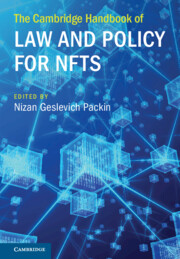Book contents
- The Cambridge Handbook of Law and Policy for NFTs
- The Cambridge Handbook of Law and Policy for NFTs
- Copyright page
- Dedication
- Contents
- Figures
- Tables
- Contributors
- Acknowledgments
- Part I Introduction and Background
- Part II Financial Regulation and Investor Protection
- 3 The Economic Reality of NFT Securities
- 4 Digital Assets, Anti-Money Laundering, and Counter Financing of Terrorism
- 5 NFTs and State Laws Governing Securities Regulation, Virtual Currency, and Money Transmission
- 6 New Tax-Reporting Rules for a New Class of Digital Assets?
- Part III Capital Markets, Community, and Marketing
- Part IV Intellectual Property and Ownership Rights
- Part V Data Protection, Privacy, Cybersecurity, and NFTs
- Part VI Other Legal Issues with NFTs
- Part VII Conclusions and Future Directions
- Index
3 - The Economic Reality of NFT Securities
from Part II - Financial Regulation and Investor Protection
Published online by Cambridge University Press: 02 November 2024
- The Cambridge Handbook of Law and Policy for NFTs
- The Cambridge Handbook of Law and Policy for NFTs
- Copyright page
- Dedication
- Contents
- Figures
- Tables
- Contributors
- Acknowledgments
- Part I Introduction and Background
- Part II Financial Regulation and Investor Protection
- 3 The Economic Reality of NFT Securities
- 4 Digital Assets, Anti-Money Laundering, and Counter Financing of Terrorism
- 5 NFTs and State Laws Governing Securities Regulation, Virtual Currency, and Money Transmission
- 6 New Tax-Reporting Rules for a New Class of Digital Assets?
- Part III Capital Markets, Community, and Marketing
- Part IV Intellectual Property and Ownership Rights
- Part V Data Protection, Privacy, Cybersecurity, and NFTs
- Part VI Other Legal Issues with NFTs
- Part VII Conclusions and Future Directions
- Index
Summary
Non-fungible tokens (NFTs) are used in numerous markets for collectibles, art, securities, and commodities. These are different markets, and there is no regulatory framework for all NFTs. To determine a proper legal regime, it is essential to locate the market to which an NFT belongs. This task requires a deep understanding of the economic realities of the associated rights, assets, and transactions. Economic-reality-based interpretations should provide a solid footing for better regulation of NFTs in the US and other jurisdictions grappling with NFT regulation. The new cryptoasset regime in the EU already incorporates a “substance over form” approach. In the US, courts have been successfully applying the Howey test to examine transactions and schemes and establish whether securities law should apply to cryptoassets. In 2023, the SEC and a US federal district court applied the Howey test to demonstrate why and how securities law built for legacy markets where mainstream assets are fungible could apply to transactions in non-fungible assets. The decisions are an example of establishing economic realities of transactions with novel assets regardless of the underlying technologies on which the assets are built. An economic reality approach should help courts and other policy-makers ascertain to which market an NFT belongs and which corresponding legal regime should govern.
- Type
- Chapter
- Information
- The Cambridge Handbook of Law and Policy for NFTs , pp. 59 - 77Publisher: Cambridge University PressPrint publication year: 2024

